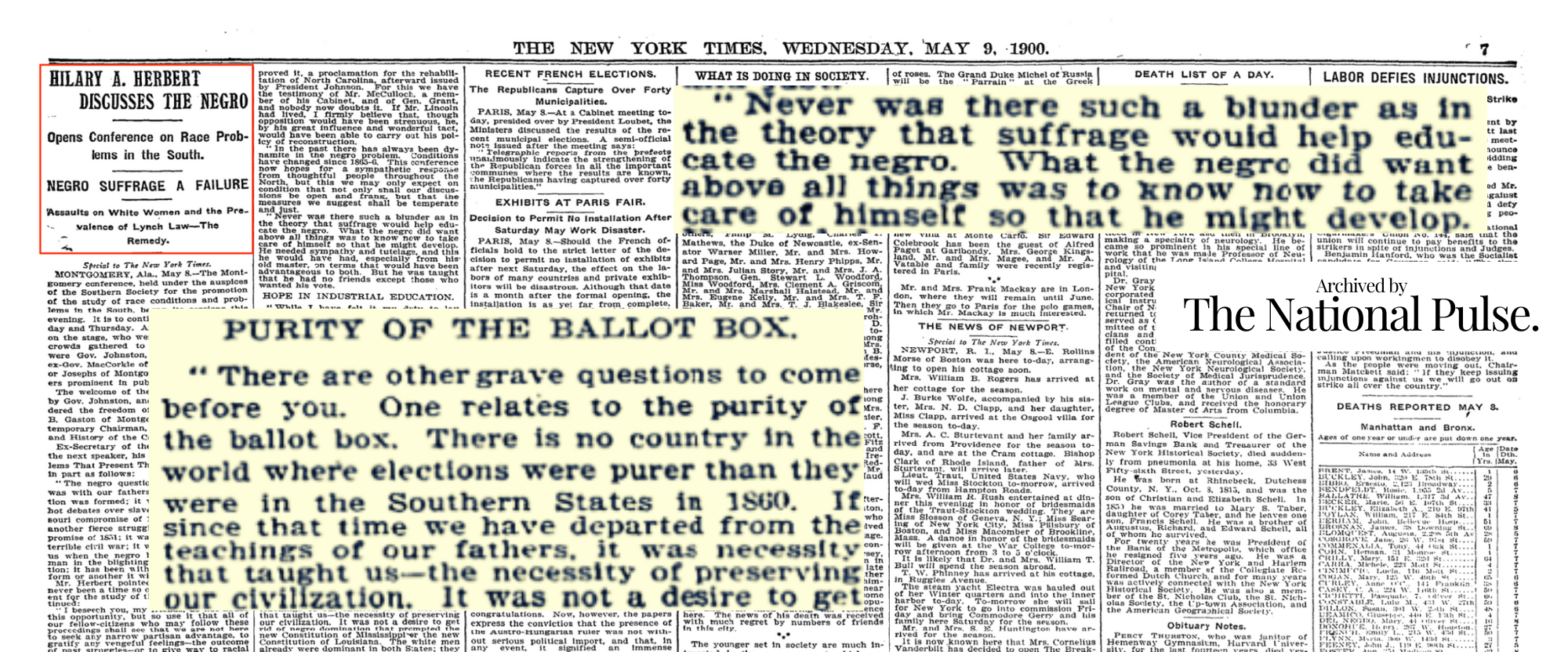The family who owns the New York Times were pro-Confederacy slave owners, and The National Pulse can today reveal the Times‘ fawning coverage of an anti-black vote conference with pro-lynching advocates in attendance. The paper’s headlines from the time declared: “NEGRO SUFFRAGE A FAILURE.”
Writing in the New York Post this weekend, columnist Michael Goodwin explained The New York Times, under the leadership of Arthur Ochs, published an editorial in 1900 saying the Democratic Party “may justly insist that the evils of negro suffrage were wantonly inflicted on them.”
The Ochs-Sulzberger family still owns the paper, with Arthur Ochs Sulzberger Jr serving as its Chairman, and his son, A.G. Sulzberger serving as Publisher.
NEW REVELATIONS.
Further investigation by The National Pulse reveals a far more horrific history of anti-black sentiment from the pages of the New York Times – the rag which maintains the original Ochs’s established strap line: “All the News That’s Fit to Print.”
That same line appeared above an editorial from Thursday, May 10th 1900.
“The Political Future of the South,” lamented the “negro vote,” referring to the “horrors of negro rule,” and blasted Republicans for promoting and passing legislation that went onto become the Fifteenth Amendment to the Constitution of the United States, which states that “race, color, or previous condition of servitude” cannot be used to stop someone voting.
“The Republican Party committed a great public crime when it gave the right of suffrage to the blacks,” the Times roared on page six, calling “barriers against negro suffrage” a consequence of “wiser counsel.”
One day prior, on May 9th 1900, the paper gave fawning coverage to the former Secretary of the Navy Hillary A. Herbert, who had convened a conference titled “The Race Problem.”
Herbert, a Democrat who served under President Grover Cleveland, said at the time that the black vote had “brought weakness instead of strength,” and the New York Times cribbed his speech for the headline which blasted: “NEGRO SUFFRAGE A FAILURE.”
“White men in every State have obtained control and they must keep it,” Herbert declared, adding: “Idleness amongst the negros is undoubtedly growing, and crime appears to be increasing.”
Herbert went on, published in full and without criticism or context added by the Times:
“There are other graves questions to come before you,” he told the opening day of the “Race Problem” conference, concluding: “One relates to the purity of the ballot box.”
In a follow-up on Friday, May 11th, the Times ran a summary of what was clearly an important conference to their minds, leading with the proclamations of statistician Prof. W. F. Willcox who said at the time: “There will be a rapid decrease of the birth rate and a slow increase of the death rate until the negro race will stand as the American Indian stands to-day.”
The summary article went on to reflect on the “advisability of lynching,” as set forth by a number of speakers at the event.
Those who might suggest the Times was simply reflecting common parlance or attitudes at the time would be mistaken. Their own Letters page gave way, one day later, to Pastor Pierce Butler Thompkins founder of the Saint James Presbyterian Church in New York, who rebuked the Times for its coverage of the event.
“[Y]ou seem to be willing to sacrifice principle for expediency,” wrote Butler Thompkins, reflecting on the nature of the paper’s coverage which sought to tacitly approve of measures by which to suppress the black vote with the hope it would help the Democratic Party.
CELEBRATION OF CONFEDERATES.
In addition to this slew of anti-“negro” coverage, the Times published a profile of Confederate President Jefferson Davis on the 100th anniversary of his birth, defining him as the “the great Southern leader.”

According to Goodwin, Adolph Ochs went further in his support for Confederate leaders by making large contributions to memorials such as the Stone Mountain Memorial in Georgia that celebrates Jefferson Davis, Robert E. Lee, and Stonewall Jackson.
The donation was particularly noteworthy as at a cost of $1000 (around $31,000 today), he could include his late mother’s name on the founders’ role of the memorial, along with a letter that stated “Robert E. Lee was her idol.”
The letter was noted by historians in 2015, when Confederate flag tiles were spotted in the Subway station beneath Times Square.
Ochs made clear his support for the South was not euphemistic. He said in an editorial, according to Civil War Times magazine:
“I concede to no newspaper publisher in the South a more loyal, sincere, enthusiastic and industrious advocacy of the best interests, welfare and prosperity of the South than I have shown in the Chattanooga Times and The New York Times. I am confident that all to whom I am known will attest that the South, its interests and its welfare have been and are part of my religion and profession and hobby.”
His mother, Bertha Levy Ochs, actively assisted the Confederacy throughout the civil war.
She was caught smuggling medicine to citizens of the Confederacy by concealing them in a baby carriage. The commitment she had to the South was something she had gained from her uncle, John Mayer. Prior to the Civil War, it is believed Bertha lived with Mayer in Natchez until 1853.
ENRICHED BY SLAVERY.
Records show that in 1860, Mayer reported that he owned 5 slaves. Although the records do not indicate the names of those individuals, Goodwin reports that two were male, ages 70 and 26, and three were females, ages 65, 45, and 23.
The mother of the New York Times owner, Adolph Ochs – whose family still owns the paper – partook in the slave trade while she stayed with her uncle. Nor did her actions end there.
In later life Bertha became a charter member of a Daughters of the Confederacy chapter and requested that a Confederate flag be draped across her coffin. It was.
Adolph Ochs, credited with turning a failing local newspaper into a globally recognized publication, has both pro-confederate and pro-slavery connections in almost every corner of his family.
Whether through his mother’s brother, Oscar Levy, who fought alongside his cousins for the Confederate States, his mother’s uncle, John Mayer who owned at least 5 slaves and organized a home-guard unit throughout the war, or Bertha Levy Ochs herself, who had the Confederate flag adorn her coffin as it was lowered into the ground.
The New York Times that today pushes the widely disputed ‘1619 Project’ has at its core, a deep and documented relationship with the very people it now claims to despise.
Editor’s Note: While The National Pulse does not believe in cancel culture, nor in erasing American history, we believe it is important to point out the hypocrisies of those who would seek to lecture to the contrary.
Nick Regan contributed to this report.




